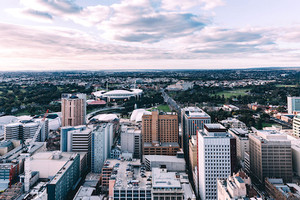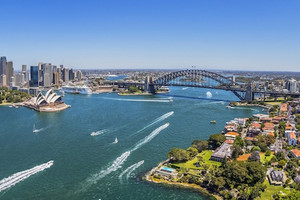
Adelaide is the perfect city to explore on foot, and first time visitors will quickly discover that it is a city which wasn’t so much founded as it was planned. Before a brick was ever laid, the concept of South Australia’s premier city was decided in great detail in the 1830’s. Sitting on the flat coastal plain between Gulf St. Vincent and the Mount Lofty Ranges, Adelaide is essentially two grid-systems flanking both sides of the Torrens River; a business and cultural heart in the south, and residential suburbs in the north. The two areas are conveniently linked by three bridges and a footbridge, with some eye-catching and leafy wide-open spaces in between, which makes it an airy, compact city which is a delight to explore. And laid out in a series of neat, easy-to-follow grids, most of Adelaide’s primary attractions can be comfortably ticked off any “must do” list in just a couple of days.
Day One
Morning: There’s no better way to start the day than with a bit of light exercise, and after exploring Adelaide’s cultural strip, North Terrace, from the western end, Adelaide’s sprawling Botanic Gardens is an oasis of calm at the eastern end. Of the multitude of attractions within the Gardens, the Palm House is one of the most impressive; an exquisite Victorian glasshouse imported from Bremen in 1875, and fully restored in 1995. It’s worth taking a picnic lunch with you if you can, and after a stroll along the garden’s serene pathways, sitting down to feast your eyes on the sacred lotus plant which thrives in the Nelumbo Pond.
Afternoon: At the top of Gouger Street, Adelaide’s Central Market is open on Tuesday, and from Thursday to Saturday, and is almost as old as the city itself. Trading here began as far back as 1869, when a small group of market gardeners sold their item produce within hours, and today it’s the largest covered market in the southern hemisphere, as well as one of South Australia’s top tourist attractions, attracting eight million people each year. The range of produce on sale here is overwhelming, and there are plenty of little stalls and cafés selling lunch, snacks and great coffee. A few blocks south and Gilles Street Market attracts fashion enthusiasts looking for bargains on designer samples and clearance stock from some of Australia’s best young designers, while Rundle Mall and Rundle Street have more than 800 retail outlets. Prospect Road, O’Connell Street and The Parade are all worth checking out for some more unusual offerings.
Evening: Hindley and Rundle Streets are our top picks for exploring Adelaide’s nightlife. Wine buffs will appreciate Apoteca, formerly known as the Apothecary 1878 (118 Hindley Street). Located in a stunning heritage listed building, it’s one of Adelaide’s most trendy watering holes, boasting an impressive menu of champagne and wine. For beer lovers, however, The Belgian Beer Café (27-29 Ebenezer Place) is tucked away just off Rundle Street, and packed with unique flavours from Belgium, and a place where the pouring of beer is an art form. It’s still Adelaide’s only true Belgian beer pub. Night owls should head for the renowned Moskva Vodka Bar (192 Hindley Street), which has four bars across three levels, including champagne and shot lounges.
Day Two
Morning: Wandering North Adelaide’s tree-lined streets and serene parks can make you feel like you’re a long way from the city, but the reality is that it’s just a short walk from the bustling CBD. The banks of the Torrens River are lined with walking and cycling paths, and a wander along here usually attracts the resident black swans, which are no doubt looking for an easy meal. King William Road crosses the river and leads to the beautiful St Peters Cathedral which was designed in England. The twin-spired structure is one of the main attractions in this area and nearby the statue of the legendary cricketer, Sir Donald Bradman, also adds to the austere atmosphere. Fittingly the elegant Adelaide Oval cricket ground is nearby, and northwest of here on a hill is Light’s Lookout, which pays homage to Colonel William Light who designed the city in the 1830’s. This offers a great view of the city with the Adelaide Oval in the foreground.
Afternoon: A day trip to Glenelg on one of Adelaide’s famous trams is a must for most first time visitors to the city. It’s a petty beach suburb located just 10 kilometres from the city, and going there is a ritual the locals have indulged in for decades to wander the iconic seaside resort or tuck into some local fish and chips. These days there are plenty of hotels, bars and restaurants all built to complement the “outdoorsy” feel, and for history buffs, the magnificent Glenelg Town Hall remains the heart and soul of the district, and a place of great importance as it was where South Australia was proclaimed a British Province way back in 1836.
Evening: For a spot of nightlife with a bit of difference, aim to spend some time in Adelaide’s more traditional watering holes at least one evening. Top of your list to check out should be the famous Gilbert Street Hotel (88 Gilbert Street), a delightful corner pub in the south eastern corner of the city with a friendly atmosphere and a lovely beer garden in which to enjoy hot summer nights. Another great option is the Crown & Sceptre (308 King William Street). Known locally as Adelaide’s “bartenders’ bar”, it’ famous for an artful décor, unusual Cooper’s Cocktails, a char grill restaurant, and great entertainment.
- By:
- Joanna Hall
Reviews
-
Surprise
My husband was based in Adelaide for work for a couple of months and I visited several times....I was surprised by what a great, compact city it was with great food and cafe culture!
-
Ta
Thank you for promoting our beautiful city where all visitors are welcome!











